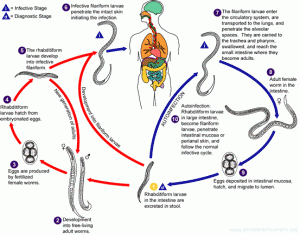Strongyloides stercoralis is a 2 mm long intestinal worm causing a disease called strongyloidiasis. It is common in tropical and subtropical areas but also occurs in temperate zones. Unlike most parasitic worms, Strongyloides stercoralis has a heterogonic life cycle. So in addition to the parasitic life cycle it has a separate free-living cycle where it lives and reproduces without a host in the soil. Strongyloides stercoralis can autoinfect the same host over and over without any intermediate host. This makes strongyloidiasis a very persistent disease.
Parasitic life cycle: A microscopic filariform (L3) larva penetrates bare skin that touches Strongyloides stercoralis infested soil. It enters the bloodstream ending up in the pulmonary capillaries. There it exits the blood and enters the lung alveoli. It is taken out of the lungs by the movement of microvilli through the bronchus and trachea to the throat where it is swallowed. Eventually it reaches the small intestine where it develops into an adult female by molting twice. The female lives burrowed into the intestinal wall. It reproduces asexually (by parthenogenesis) and releases eggs from which first stage larvae called rhabditiform hatch. They either exit the body in the stool or molt twice into infective filariform larvae. A filariform larva either penetrates the intestinal wall (internal autoinfection) or if already in the anus, it penetrates the outside/perianal skin (external autoinfection). Then it goes through the same routine: blood, lungs, stomach and back to the small intestine where it matures into adult.
Free-living life cycle: In the soil rhabditiform larvae either develop into filariform larvae or into adults. If a larva molts only twice, it becomes a filariform larva which is the infective stage and can invade humans. If the rhabditiform larva molts four times, it becomes an adult which can survive and reproduce in the wild. The free-living male and female mate and produce eggs. The offspring can either become infective filariform by molting twice or develop into adults by molting four times. The adult worms only live through one copulation cycle in the wild. But inside humans (only females there) adults can survive longer.
Minor infections can be asymptomatic but usually one or more of the following symptoms occur:
- anemia (for example, pale skin)
- constipation
- cough
- diarrhea
- eosinophilic pneumonitis (during larvae migration through the lungs)
- nausea
- rashes in waist and buttocks
- stomach ache
- vomiting
- weight loss.
Immunosuppressed patients (immune system weakened intentionally after an organ transplant or suchlike) or immunocompromised patients (immune system weakened by another disease such as HIV) can have also some of the following symptoms:
- death
- distension
- neurological and pulmonary complications
- septicemia
- shock.
Diagnosis is done by microscopic examinations of duodenal or stool samples. Many samples are usually needed to make the diagnosis.
Strongyloidiasis is treated with ivermectin according to the advice of your health care provider. Ivermectin only kills adult parasites so you must take the medicine periodically to get rid of the later developed worms. In addition to ivermectin, thiabendazole andalbendazole are also sometimes used.

